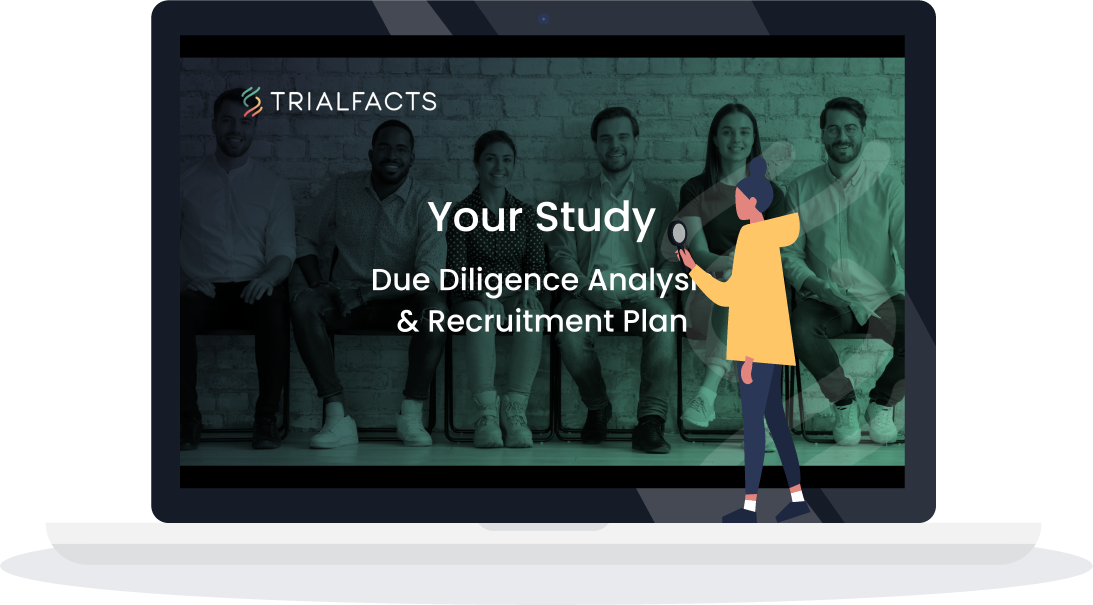If you are ready to see how many participants we can guarantee for your study, request your free, no-obligation recruitment plan today. Click the button below and fill out the 30 second form to get started.

Dr. Doug Paddon-Jones is a professor and clinical researcher based in the Department of Nutrition & Metabolism at the University of Texas Medical Branch.
Over the last several years, Dr. Paddon-Jones has developed a keen interest in nutrition and physical activity-related research as it relates to aging, muscle mass and function.
In his most recent study, Dr. Paddon-Jones and his colleague, Dr. Emily Lantz, set out to look at the issue of complete and incomplete protein in healthy people’s diets.
But with the requirement of three separate 24-hour hospital visits, blood sampling and invasive muscle biopsy procedures – not to mention drawing from a limited pool of local volunteers – they knew recruitment would be a challenge. They recognized they needed a new recruitment angle from the start.
Drs. Paddon-Jones and Lantz, set out to answer a simple question: to effectively stimulate muscle growth and repair, do humans need to consume a full complement of essential amino acids at every single meal?
“A familiar, practical example is the age-old tradition of combining rice and beans in a single meal,” Dr. Paddon-Jones explains. “We know that rice, for example, is low in lysine, so doesn’t contain the full complement of essential amino acids. Beans don’t either, but they lack a different amino acid – methionine. However, if you combine them together, you get a full complement. A similar example is combining wheat/bread and beans”
Dr. Paddon-Jones goes on to detail how his interest in the study began. “A simple internet search on ‘combining proteins or complementary proteins’ will return pages of results that basically say don’t worry so much about combining rice and beans, or different protein sources at each meal – look at the broader 24h picture”.
“But there’s really not a whole lot of evidence to support this recommendation; in fact, we contend that a meal-based focus is key. I’m being hyperbolic, but let’s say you ate a meal consisting of a literal bucket full of beans – nothing else (not recommended!). That meal would contain a LOT of protein, but it still wouldn’t provide the full complement of essential amino acids, needed to turn on the muscle-building process,” he hypothesizes.
The study itself is fairly simple: The research team hoped to recruit 20 participants to split into a control group and a test group.
The control group would consume a very low-protein breakfast of rice cakes and fruit. The test group would visit the clinical research center on three separate occasions where they would be provided with one of three different meal patterns: i) beef-based, complete protein meals, ii) wheat and bean complete/complementary protein meals, and iii) wheat or bean, incomplete protein meals. All the meals would contain 25 grams of total protein and over a 24 h period would have a similar macronutrient profile.
“We anticipate that the beef-based and the complementary wheat-and-bean-based meal patterns will stimulate a robust protein synthesis (muscle-building) response. However, we hypothesize that the incomplete protein meal pattern (wheat or bean meals) will have little to no effect on protein synthesis.
“Ultimately, we think separating the wheat and the beans into different meals will not stimulate protein synthesis and may not be any better than the low protein rice cake control group.
From the beginning, the team knew finding qualified candidates would be hard.
“One of our biggest challenges is recruiting study volunteers who meet our strict health and safety criteria. In the past when we used simple recruitment flyers, we would receive a lot of initial volunteer interest because it was a ‘diet or metabolism study.’ Traditional recruitment flyers contain a limited amount of information. Prospective volunteers may not always have a great idea of what they’re signing up for. Inevitably, you end up with a lot of screening failures.”
“One of our biggest challenges is recruiting study volunteers who meet our strict health and safety criteria. In the past when we used simple recruitment flyers, we would receive a lot of initial volunteer interest because it was a ‘diet or metabolism study.’ Traditional recruitment flyers contain a limited amount of information. Prospective volunteers may not always have a great idea of what they’re signing up for. Inevitably, you end up with a lot of screening failures.”
Dr. Paddon-Jones
University of Texas Medical Branch
“We ask our volunteers to commit to three separate study visits. Having a volunteer drop out after the first visit is terribly disappointing. While volunteers have an absolute right to pull out of a study at any time, we wanted to make sure they really understood what they were getting involved in – no surprises.”
With so many specific study requirements, Drs. Paddon-Jones and Lantz realized early on that traditional recruitment methods weren’t likely to be the most effective or efficient strategy.
To start, the research duo began spreading the word about their study throughout the university.
“We placed adverts on a series of televisions and monitors around the university and in the hospital. It’s a no-cost exercise and easy way to reach out to our local community,” he remembers.
The team also created flyers and began posting them in traditional locations; coffee shops, gymnasiums, community centers. However, their prints were hanging among a sea of others. With that kind of competition, it was tough to reach a specific audience.
“I was a little worried that the Facebook ads and initial screening process would be little more than shiny-glitzy click-bait. My fear was that we would get inundated with volunteers who would ultimately be ineligible or not interested”
Dr. Paddon-Jones
University of Texas Medical Branch
Though there was some interest expressed from all their traditional recruiting angles, it wasn’t enough.
Having never used a recruitment agency before, Dr. Paddon-Jones was hesitant about reaching out for help. Like many researchers, he worried about losing time and money with few promising results.
Setting aside his concerns, Dr. Paddon-Jones first contacted Trialfacts in September 2018.
“We were getting ready to launch,” he recalls. “We used Trialfacts right from the get-go.”
“I’d heard about your service from a colleague. She had tried a couple of different services. So we looked at the website and did the Due Diligence Process. It just happened to correspond to when we were ready to start ramping up recruitment.”
Feeling good about the decision, the team took a leap of faith.
“We went, pretty much, all-in and benched our traditional approach. We did look at a couple of other options but ultimately our decision to work with Trialfacts was based on the detailed information presented on your website and my colleague’s experiences.
“It made sense when we looked at the process and the steps. But a little of it was… well, a little bit of blind faith,” he says candidly.
When asked how recruitment went for his study, Dr. Paddon-Jones didn’t mince words: “Working with Trialfacts was ruthlessly efficient!” he laughs.
“Working with Trialfacts was ruthlessly efficient! You can access your recruitment page from anywhere. We used the Trialfacts phone screening system to call volunteers at the right time regardless of where we were. We could respond to subjects from the lab or hospital without needing to always be in the office.”
Dr. Paddon-Jones
University of Texas Medical Branch
“Very early on, we got to the point where we had to say, ‘Slow down! We’re getting too many hits!’ Which, you know, no one has ever said ,” he laughs again. “It was really great.
In addition, with the onset of the COVID pandemic, being able to work on recruitment from anywhere also played a major role in the research team’s recruiting success.
“Working with Trialfacts was ruthlessly efficient! You can access your recruitment page from anywhere. We used the Trialfacts phone screening system to call volunteers at the right time regardless of where we were. We could respond to subjects from the lab or hospital without needing to always be in the office.”, he says.
Through the pre-screening process, Trialfacts helped exclude 50% of poorly-matched volunteer inquiries which helped Dr. Paddon-Jones get the right participants for his study.

The initial online ad and telephone screening processes proved to be incredibly effective for the team.
“ We compared the number of people who we contacted with the percentage who passed the phone screening. Such a high success rate was a game-changer for us,” Dr. Paddon-Jones shares.
Dr. Paddon-Jones further explains the benefit of the acceptance and rejection process.

“A lot of recruitment-related stress is removed. You can really focus on enrolling the best candidates and be fully transparent. To be able to do that from the very start of the study and not waste anyone’s time was a breath of fresh air,” he says earnestly.
The study is ongoing and results aren’t likely to be finalized until March 2021. But despite that, Dr. Paddon-Jones feels like he’s found a “new normal” for trial recruitment.
Real-time reports and spreadsheet records helped Dr. Paddon-Jones pass on important recruitment and enrolment information to the study sponsors.
“One of the major benefits of Trialfacts was access to a wide range of tables describing the volunteer demographic breakdown, and screening and enrollment outcomes. To have all of that data automatically generated and available for progress reports made the process so much simpler.”
Dr. Paddon-Jones
University of Texas Medical Branch
“For most grants, every 6-12 months, you need to provide an update for the sponsor on how you’re doing. But with our study, we planned to batch analyze all the tissue samples at the end of the study.

“So one of the major benefits of Trialfacts was access to a wide range of tables describing the volunteer demographic breakdown, and screening and enrollment outcomes.’ To have all of that data automatically generated and available for progress reports made the process so much simpler.” Dr. Paddon-Jones says.
Dr. Paddon-Jones also credits the ability to fully inform volunteers from the very beginning of the recruitment process.
“For example, for some people, muscle biopsies are going to be a deal-breaker… The screening setup allowed us to say, ‘Here are the risks and the potential challenges you might face with the study,’ and we could do that really early on – some of it on the pre-screening questionnaire even before we saw them and before the phone screening,” he explains.
Giving a new system for recruitment a try was such a success for the team that they intend to repeat the process again with future trials.
Dr. Paddon-Jones also points out how working with Trialfacts helped the team reach outside the traditional recruiting boundaries of the local community.
“Many of us are in institutions or universities where other research teams are trying to recruit a similar population, but with Trialfacts, you’re not directly competing.
“You’re not putting research flyers on top of each other; you’re not treading on anyone’s recruitment toes. It took away a lot of potential stress. It gives your team a bit more autonomy,” he explains.
Drs. Paddon-Jones and Lantz’s research stands to make a big impact on our understanding of nutrition and muscle-building.
“We make small but practical advances. When they’re applied to the right people and the right situation, they can be really useful,” he says.

If you are ready to see how many participants we can guarantee for your study, request your free, no-obligation recruitment plan today. Click the button below and fill out the 30 second form to get started.

Paratus Clinical recognized the need for a high ROI as they began to invest in clinical trial patient recruitment. They needed to recruit as many participants as possible while using their sponsor’s funding wisely.